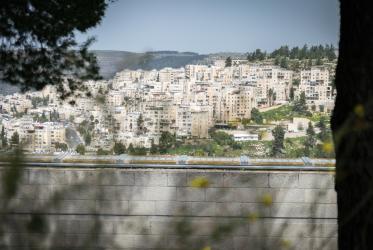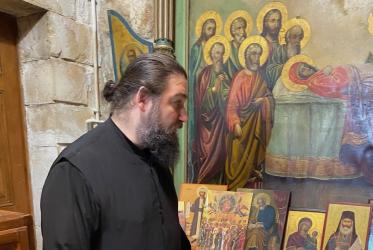by Theodore Gill (*)
Is there real potential for visible unity among today's churches, or are cultural and dogmatic differences too great to be overcome? These were key issues raised on Friday 9 October in five presentations at the Faith and Order conference in Kolympari, Greece.
Christians from many theological traditions and regions of the world gather under the banner of Faith and Order to compare their perspectives on religious doctrine, worship and faithful action in the world. Church representatives from five contexts spoke on Friday as part of the 7-13 October meeting of the Faith and Order Plenary Commission, an advisory body to the World Council of Churches. The meeting has brought more than 150 participants to the Orthodox Academy of Crete.
“Called to Be the One Church” was the stated theme of the deliberations, yet the variety marking the five speeches bore witness as much to Christian diversity as to unity. Later discussions in the plenary and smaller groups questioned the extent to which the presenters' positions were, as Prof. William Henn of the Pontifical Gregorian University in Rome expressed it to one group, “mutually contradictory, or complementary?”
The speakers ranged in confessional background from Lutheran to Reformed, from Anglican to Roman Catholic to Eastern Orthodox, and they came to Crete from many points of the compass: Finland, South Africa, Cuba, China and the Ecumenical Patriarchate of Constantinople.
Minna Hietamäki from the Evangelical Lutheran Church of Finland described a “strong tendency toward oneness” in the relationships of Finnish churches, yet she discerned a simultaneous “strong theological intuition, if you will, of diversity, dynamism and life”. As a professor she reported that her students often seem more fascinated by exploration their own identity than seeking unity. “I think there is still some way to go”, she concluded, “for us to realize and take in the strangeness of the stranger”. Nevertheless, she expressed hope that Faith and Order can help facilitate “encounters where we can, if but for a short moment, embrace and appreciate the other without losing our own identity”.
“Christianity begins in South Africa as a divided community,” according to Maake Masango of the Uniting Presbyterian Church in Southern Africa. The early missionaries imported divisions from Europe, and this was exacerbated by racism, apartheid and economic classes based on wealth and poverty. Masango described ways in which theological institutions began to overcome divisions, establish common faculties for theological training and unite denominations into broader churches such as his own. Division still exists, and this condition demands honesty of Christians as they join in dialogue. Recalling an English expression, “straight talk does not break any friendship”, Masango used the example of union talks among the Protestants of South Africa as an example for frank discussion within the ecumenical movement.
Marianela de la Paz Cot, of the Episcopal Church of Cuba, and Maria Ko Ha Fong, a Silesian sister who teaches at Catholic institutions in Rome, Hong Kong and the mainland of China, raised the issue of combining the search for Christian unity with a concern for Christians' role in promoting the unity of humanity.
The Cuban speaker described interchurch and interfaith dialogue as sources and meeting points of opposing views and potential polarization, but she argued that this provides “an opportunity to develop a deeper unity”. Her argument that “revelation is polyphonic”, and the meaning best discovered in company with others, aroused criticism during the question period that followed her address. When must respect for others' beliefs give way to a prophetic critique of idolatry? How can one balance the call to extended community with the call to speak truth in the presence of error? At what point is faith in Christ compromised? Such questions will be discussed further in coming days.
Sister Maria reminded her audience that two-thirds of the world's population lives in Asia but that only three percent of that population is Christian. As a result, “in the Catholic Churches in Asia in general, the primary emphasis has been given to inter-religious dialogue, considered to be more urgent and more important than ecumenical dialogue.” She suggested that the intersection of dialogues among churches and world faiths may be found in a focus on the kingdom of God. She expressed the belief that, “notwithstanding our differences, we can find a measure of communion in our common confession of faith in Christ and in our common mission of revealing the presence of the kingdom of God in the world.”
Metropolitan Gennadios of Sassima celebrated advances in Christians' understanding of one another through the ongoing study of ecclesiology, or the self-understanding of the church. It is only within recent decades, he reminded younger listeners, that members of such a wide range of churches have been willing to sit together and listen to one another with respect. He underlined an Orthodox contribution to this conversation: a vision of the church's “unity in multiplicity” taking its inspiration from the interplay of the persons of the Holy Trinity who are, at the same time, Three and One. The mission of the one church in its various manifestations, he said, is “to proclaim God's purpose for the world and to live it out in historical contexts and situations”.
(*) Theodore Gill is senior editor of WCC Publications in Geneva and a minister ordained by the Presbyterian Church (U.S.A.)
Dr Minna Hietamäki's presentation
Prof Maake Masango's presentation
Rev. Dr Marianela de la Paz Cot's presentation
Sister Maria Ko Ha Fong's presentation







